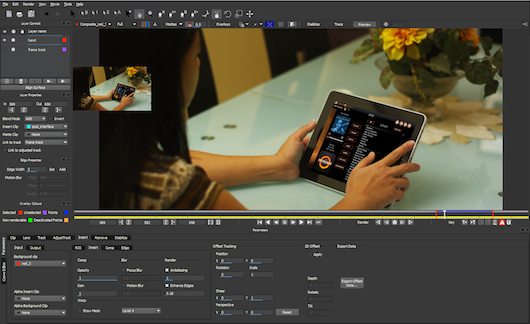This Incredibly Fast 64-bit Planar Tracker Will Help Any Facility Save Time Changing Elements in Even the Most Complicated Scenes
To handle that billboard, I typically go into After Effects, manually place the insert for the billboard and create and animate a mask for the object that is in front of said trees and talent. At least that’s how I used to do it. Then I found Mocha, from Imagineer Systems.
Mocha Pro, like the original Mocha, uses planar tracking to track regions of planar surfaces in your footage, not just a few local pixels, computing not only second variables, such as X-Y movement, rotation and scale, but 3D elements such as perspective, for ultra-convincing replacement of any part of your scene. Not spending much time creating visual effects I was surprised how useful a tool like Mocha was to a full-time editor for situations like he billboard, and a great deal of other things, too.
Mocha’s primary uses include brand replacement, item removal and logo replacement. We once had to remove a controversial book from a bookshelf in the background in one project and it came in very handy. Mocha Pro also helped us on a recent project, a promotional video for a client’s upcoming iPad app. The app itself is still in beta and too early for a copy to work on a native iPad, so we had to get by on simple animations based on developer screenshots. As we all know from software development, a project can have features, menus and graphic elements added, moved or deleted all together, potentially making some of our user footage obsolete or misleading, and in effect, worthless. We took care of this problem ahead of time by shooting the iPad usage with an all-green wallpaper, giving us a good solid base to use Mocha Pro’s color tracking abilities. (It wasn’t until later I learned that this step wasn’t necessary, as the program would have had no problem with an image on screen and would have been better with perhaps just a black screen to keep some of the natural reflections from the screen.)

With a few quick splines, we were able to insert footage of the most updated versions of the app using the same original shot and create a clean roto for out talent’s hands (the results are seen below). Without Mocha we would have had to re-shoot again just to show a slightly different menu in use.

Feature Sets
In addition to its existing planar tracker and rotoscoping tools, Mocha Pro adds a number of other features that help get the job done swiftly and efficiently. Mocha Pro’s “Insert” feature tackles even tough movement situations, such as motion blur, with great results, and includes the ability to render out inserts with alphas so they are usable in other scenes. For further refinement, the mesh warp tool lets you distort the insert and make them “bend” around objects with more difficult angles. The 3D offset means you can further tweak tracking data, such as depth and rotation, making even subtle changes to the perspective of the surface easy to compensate for.
With Mocha Pro’s removal tools, tracked layers are analyzed, taking lighting and shifts in luminance into consideration. With this tool, you can accurately remove objects behind other objects by “predicting” what is behind it; the calculations are based on what it found elsewhere in the footage. Removing simple things like boom mikes or even entire objects takes much less time than it did in the previous version. You can even get granular and use the software to remove blemishes and do digital makeup retouching.
All of your planar tracking and roto data can be exported to After Effects, Flame, Fusion, Nuke and a bunch of other important hosts.
A Very Easy Learning Curve
I found Mocha Pro much easier to use and learn than point tracking, where you draw a little box around a few pixels that have a high contrast and a bigger box around the area that you want to search. Point tracking works as long as you have a clear point to track. However, as the light in your scene changes, the perspective changes or the point is inevitably blocked by something else and the track will get lost and wander off.
Mocha Pro is a separate program and opens on your system onto one large window, which can be re-sized and moved around. The controls are laid out very well and once you figure out what the icons mean, it is pretty straightforward.
The tutorials on the Imagineer web site are really well done and offer in-depth lessons on almost every one of Mocha Pro’s many parts. The online manual is also really good, with step-by-step instructions with pictures.
Performance
Mocha Pro is fast and we’ve found that it moves pretty quickly through HD files, producing amazing results. It takes a few minutes to make the tracks, depending on how complex and long they are. The way the software makes roto-masks and tracks them is where it really shines, however. The speed with which it does this means you’ll blaze through most of your rotoscoping tasks. I’m talking about cutting times in half and, sometimes, even cutting the time down to 10% of the original. We’ve saved hours on each rotoscope job.
Nino Del Padre launched his Del Padre Digital in 1991. Today he oversees a business that now encompasses digital cinematography services, animation and interactive design solutions to ad agencies, corporate clients, broadcast networks and the entertainment industry, as well as partnerships with institutions as diverse as LEGO, Hasbro and NASA.
http://www.ninodelpadre.com/












i cant find remove tool in cs6 mocha !!!
can you help me